|
|
|
|
|
|
|
Achi-Kochi Japan
Showing many places to visit and foods to eat in Japan
|
|
|
|
|
|
|
|
|
|
|
|
|
Japan
> Kyushu region
> Takachiho Town
|
|
|
|
|
|
|
Yoshinogari Historical Park
Saga Pref., Kyushu ( Achi-Kochi Japan )
|
|
|
|
|
|
|
|
|
|
|
|
|
( "Achi-Kochi" in Japanese means "Here and there" in English. )
Yoshinogari Historical Park
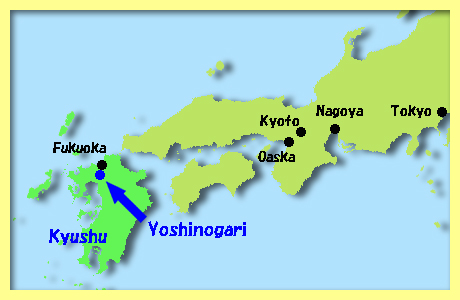
It is said that there had been dozens of small states in Japanese archipelago in Yayoi Period ( ==> A History of Japan vol.1 Formation of Japan ). Yoshonogari archaeological site ( above ), located in Saga Prefecture, Kyuhu Region, is ruins of the settlement, which had been the political center of one of such small states in Yayoi Period.
|
|
Reconstructed Structures

Yoshinogari was one of the largest settlements constructed in Yayoi Period. The ruins of structures excavated at the Yoshinogari archaeological site were so important and the site was designated as a Special National Historic Site, where Yoshinogari Historical Park was built and many structures were reconstructed as they had been in the 3rd century. So many tourists visit the park to see and enter the reconstructed structures ( above ).
|
|
Carbonized Rice

Rice farming started in Japanese archipelago around 1,000 B.C. - 800 B.C. Then Yayoi Priod began. While Jomon people, hunter-gatherers, had been nomadic, Yayoi people, rice farmers, were more sedentary. It is thought that people had lived in Yoshinogari settlement from the 4th century B.C. through the 3rd century A.D. The settlement was surrounded by rice fields and carbonized rice ( above ) was unearthed in the ruins.
|
|
Rulers' Residences

Rice farming resulted in certain status distinctions. So there had been rulers' residences in the Southern Inner Enclosure, which was one of the important precincts in the Yoshinogari settlement. The above photo shows the reconstructed ruler's residence, which visitors could enter. Facing the ruler's residence, there was a large structure where leading people attended meetings.
|
|
Main Shrine
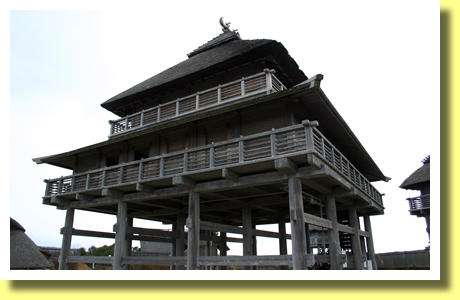
While there were the rulers' residences in the Southern Inner Enclosure, there was main shrine ( above ) in the Northern Inner Enclosure, where priests lived. The Northern Inner Enclosure was another important precinct in the Yoshinogari settlement. Visitors could walk up to the 2nd and the 3rd floors of the shrine.
|
|
Messages from Ancestral Spirits
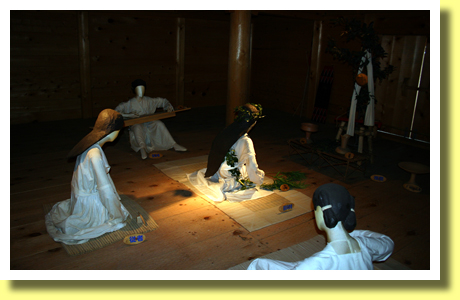
There in the Northern Inner Enclosure lived priests, who could pray to and communicate with the ancestral spirits, they believed. On the 3rd floor of the main shrine, the priest of the highest rank received messages from the ancestral spirits which mannequins reproduce ( above ) in Yoshinogari Histrical Park.
|
|
Decisions
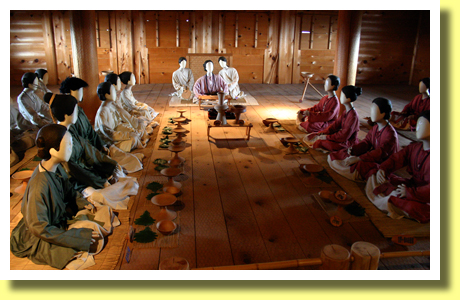
Messages from ancestral spirits were received by rulers and leaders ( above ), who had been waiting on the 2nd floor of the main shrine. Then crucial decisions were made according to the messages. Rulers and leaders needed such messages to make decisions related to rice farming, ritual ceremonies and so on.
|
|
Storehouses
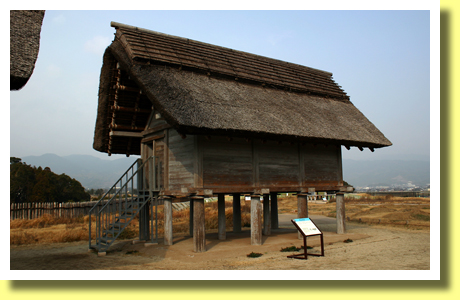
Storehouses ( above ) were reconstructed in Yoshinogari Historical Park. Seed rice was stored in such buildings. Storehouses in the Northern Inner Enclosure were used to store rice of offerings, ceremony tools, treasures and so on.
|
|
Multiple Moats

Yoshinogari settlement was surrounded by multiple moats ( above ) and walls. Some parts of moats were strengthened with sharpened trunks - abatises. The Northern Inner Enclosure, the most important precinct of the settlement, was surrounded by double moats and walls.
Rice farming made Yayoi villages fight each other for land and water. So there had been many moat-enclosed settlements in Japanese archipelago in Yayoi Period. Yoshinogari was one of the largest moated settlements at the time. They had lots to protect.
|
|
Watchtowers
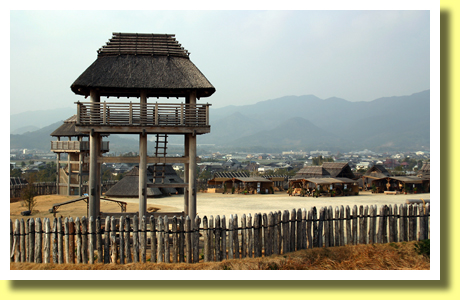
There had been several watchtowers ( above ) in Yoshinogari settlement. The sentries observed people approaching and entering the settlement. There had been guard houses in the settlement as well.
|
|
Burial Jars
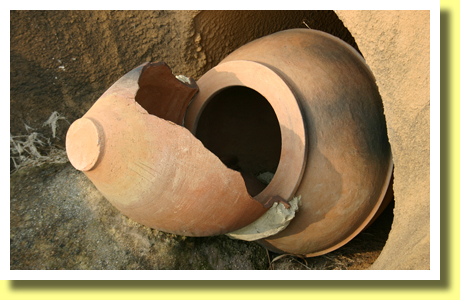
Burial Jars ( above ) were used as coffins in northern Kyushu in Yayoi Period. It is thought that about 15,000 burial jars had been buried in Yoshinogari settlement.
From Yoshinogari archaeological site excavated were bones of a few hundred people including a skeleton without head, one with arrow wound and a few with sword cuts. Some think that they had been killed in action.
|
|
Artifacts Unearthed
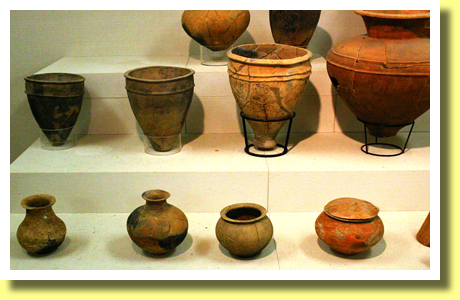
Various artifacts were unearthed from Yoshinogari archaeological site such as earthenware ( above ), coins, bronze mirrors, bells, bronze sword, knives, iron tools, glass beads and so on, Many of which are exhibited in a museum in the historic park. There are a souvenir shop and a restaurant in the park.
|
|
Moats Filled
It is thought that the moats surrounding Yoshinogari settlement had been filled by the end of the 3rd century A.D. At the time no priest nor leader served in the inner enclosures. It is not known what had happened there.
|
Copyright (c) 2021 Achi-Kochi Zanmai Co., Ltd.
|